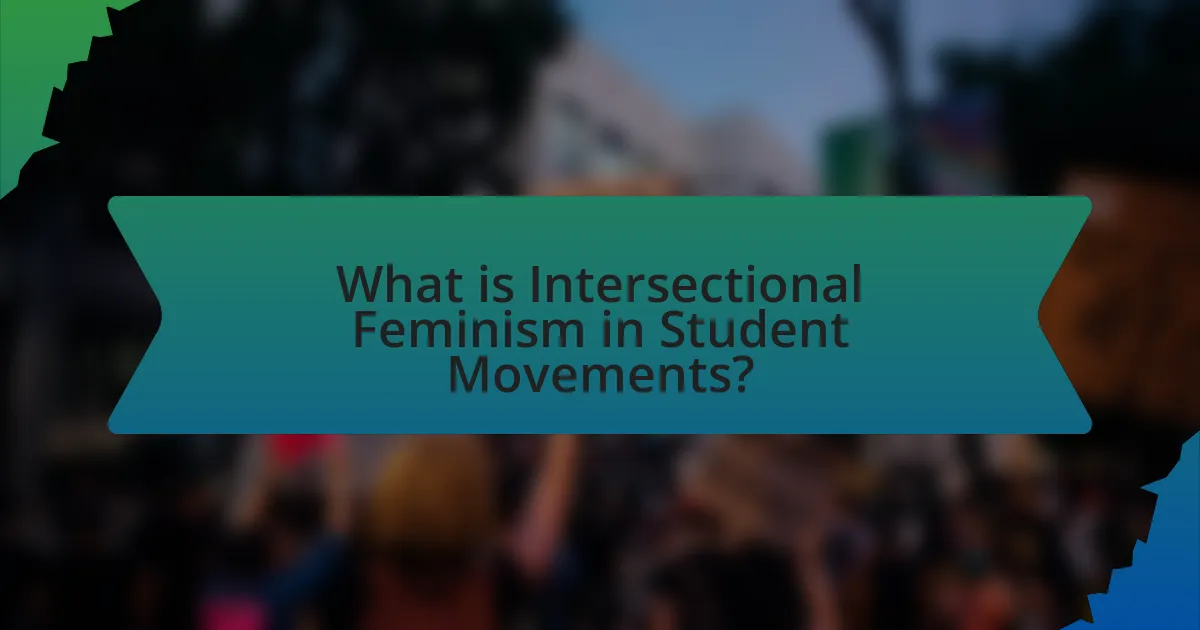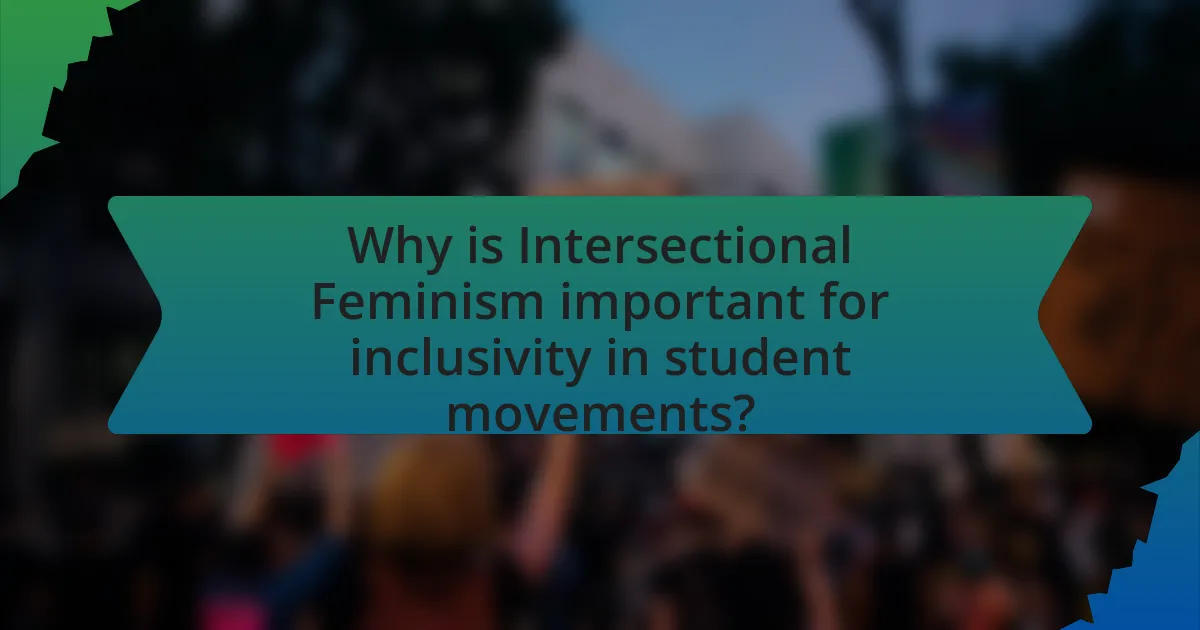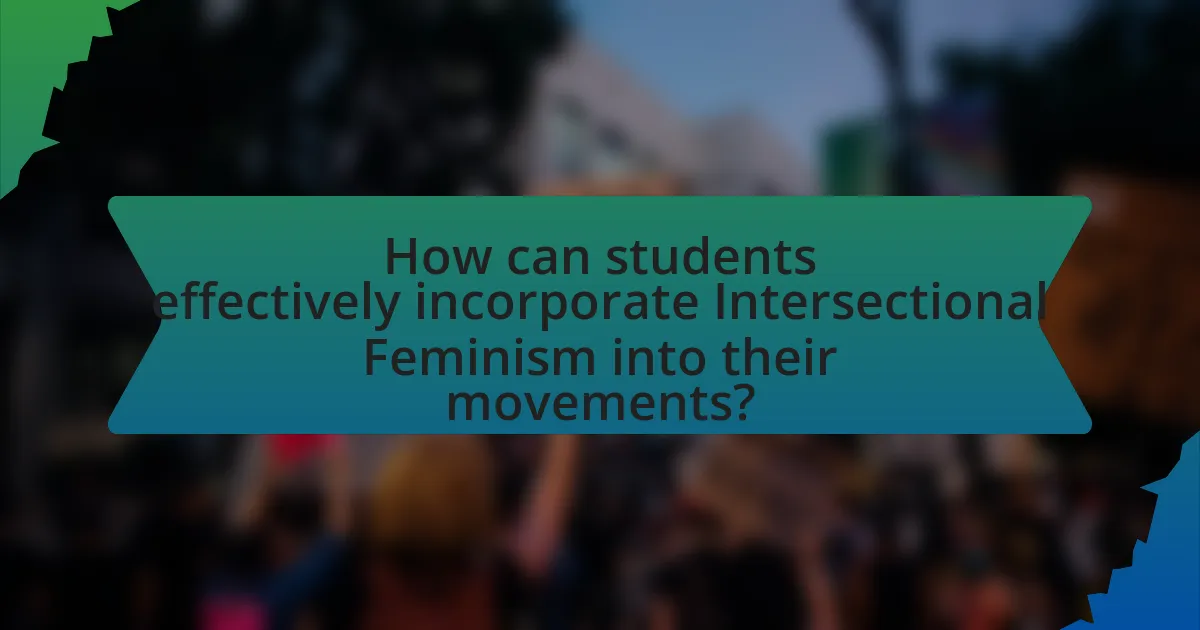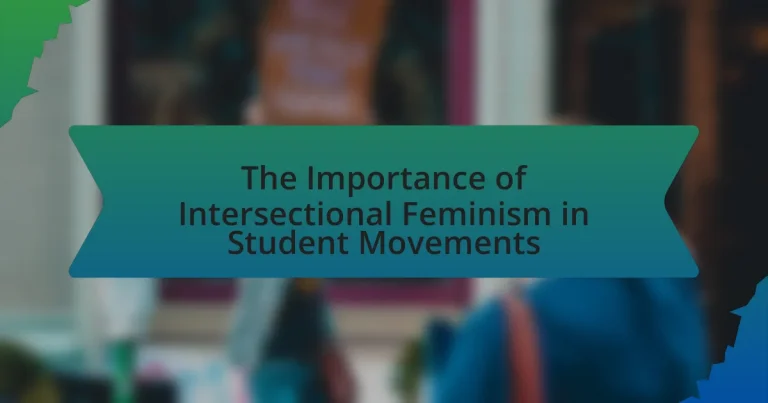Intersectional feminism in student movements is a framework that addresses the interconnected nature of social categorizations such as race, gender, class, and sexuality, which contribute to overlapping systems of discrimination. This article explores how intersectional feminism differs from traditional feminism by emphasizing the importance of recognizing diverse identities in advocating for equity and justice within educational institutions. Key principles include the necessity of inclusive approaches that amplify marginalized voices and the role of intersectional feminism in shaping student activism and policy changes. The article also highlights successful student movements that have embraced intersectional feminism and provides practical strategies for students to effectively incorporate this framework into their activism.

What is Intersectional Feminism in Student Movements?
Intersectional feminism in student movements is a framework that recognizes and addresses the interconnected nature of social categorizations such as race, gender, class, and sexuality, which create overlapping systems of discrimination and disadvantage. This approach emphasizes that student activism must consider diverse identities and experiences to effectively advocate for equity and justice within educational institutions. For instance, research by Crenshaw (1989) introduced the concept of intersectionality, highlighting how marginalized groups face unique challenges that cannot be understood through a single-axis lens of identity. Therefore, intersectional feminism in student movements seeks to create inclusive spaces that amplify the voices of all students, particularly those from historically underrepresented backgrounds.
How does Intersectional Feminism differ from traditional feminism?
Intersectional feminism differs from traditional feminism by emphasizing the interconnectedness of various social identities, such as race, class, gender, and sexuality, in shaping individual experiences of oppression. Traditional feminism often focuses primarily on gender inequality, potentially overlooking how other factors intersect to create unique challenges for marginalized groups. For instance, a study by Crenshaw (1989) introduced the concept of intersectionality, highlighting that Black women face discrimination that is not solely based on gender or race but on the combination of both. This framework allows for a more comprehensive understanding of social justice issues, advocating for a more inclusive approach that addresses the diverse experiences within feminist movements.
What are the key principles of Intersectional Feminism?
The key principles of Intersectional Feminism include the recognition that individuals experience overlapping systems of oppression based on various social identities such as race, gender, sexuality, and class. This framework emphasizes that feminism must address these intersecting identities to effectively advocate for social justice. For example, Kimberlé Crenshaw, who coined the term “intersectionality,” highlighted how Black women face unique challenges that are not addressed by mainstream feminist movements, which often focus primarily on the experiences of white women. This principle underscores the necessity of inclusive approaches that consider diverse perspectives and experiences in feminist activism.
Why is it essential to consider multiple identities in feminism?
Considering multiple identities in feminism is essential because it acknowledges the diverse experiences and challenges faced by individuals based on their race, class, sexuality, and other intersecting factors. Intersectional feminism, a term coined by Kimberlé Crenshaw, emphasizes that traditional feminist movements often overlook the unique struggles of marginalized groups, leading to incomplete solutions. For instance, Black women experience both racism and sexism, which cannot be fully understood through a singular lens of gender alone. Studies show that inclusive feminist frameworks lead to more effective advocacy and policy changes, as they address the specific needs of all women, rather than a homogeneous group. This approach fosters solidarity and ensures that feminism is relevant and effective for everyone, ultimately strengthening the movement as a whole.
What role does Intersectional Feminism play in student activism?
Intersectional feminism plays a crucial role in student activism by addressing the diverse and interconnected experiences of individuals affected by multiple forms of discrimination, such as race, gender, sexuality, and class. This approach enables student activists to create more inclusive movements that recognize and advocate for the rights of marginalized groups. For instance, research by Crenshaw (1989) highlights how intersectionality reveals the unique challenges faced by women of color, which are often overlooked in mainstream feminist discourse. By incorporating intersectional perspectives, student activism can effectively challenge systemic inequalities and promote social justice, ensuring that all voices are represented and heard within the movement.
How does Intersectional Feminism influence student-led initiatives?
Intersectional feminism significantly influences student-led initiatives by promoting inclusivity and addressing diverse social identities within activism. This approach encourages students to recognize and advocate for the unique challenges faced by individuals at the intersections of race, gender, sexuality, and class. For instance, initiatives that incorporate intersectional feminism often lead to more comprehensive policies and programs that reflect the needs of marginalized groups, as evidenced by the increased participation of underrepresented students in leadership roles within organizations. Research indicates that student movements that embrace intersectionality are more effective in mobilizing support and fostering solidarity among diverse groups, ultimately leading to more impactful social change.
What are some examples of successful student movements that embraced Intersectional Feminism?
Successful student movements that embraced Intersectional Feminism include the Black Lives Matter movement on campuses, which highlighted the intersection of race and gender in social justice issues, and the #MeToo movement, which mobilized students to address sexual harassment and assault while considering the experiences of marginalized groups. These movements have effectively raised awareness and prompted institutional changes, such as policy reforms and the establishment of support systems for survivors, demonstrating their impact on promoting equity and justice within educational environments.

Why is Intersectional Feminism important for inclusivity in student movements?
Intersectional feminism is crucial for inclusivity in student movements because it addresses the diverse experiences and challenges faced by individuals from various backgrounds. By recognizing the interconnectedness of race, gender, sexuality, and class, intersectional feminism ensures that the voices of marginalized groups are included in advocacy efforts. Research by Crenshaw (1989) highlights that traditional feminist movements often overlook the unique struggles of women of color and other marginalized identities, leading to a lack of representation and support. This approach fosters a more equitable environment, allowing student movements to effectively advocate for all members of the community, thereby enhancing solidarity and collective action.
How does Intersectional Feminism promote diverse voices in activism?
Intersectional feminism promotes diverse voices in activism by recognizing and addressing the unique experiences and challenges faced by individuals at the intersections of multiple identities, such as race, gender, sexuality, and class. This approach encourages inclusivity and amplifies marginalized voices that are often overlooked in traditional feminist movements. For instance, studies show that intersectional frameworks lead to more comprehensive activism strategies, as they incorporate the perspectives of women of color, individuals, and those from lower socioeconomic backgrounds, thereby fostering a richer dialogue and more effective advocacy. By prioritizing these diverse experiences, intersectional feminism enhances the overall impact of activism and ensures that solutions are equitable and representative of all community members.
What challenges do marginalized groups face in student movements?
Marginalized groups face significant challenges in student movements, including systemic discrimination, lack of representation, and limited access to resources. Systemic discrimination manifests through biases that undermine the voices and contributions of these groups, often leading to their exclusion from leadership roles and decision-making processes. Lack of representation is evident when the demographics of student leadership do not reflect the diversity of the student body, which can result in policies and initiatives that do not address the specific needs of marginalized communities. Limited access to resources, such as funding, mentorship, and networking opportunities, further exacerbates these challenges, making it difficult for marginalized groups to mobilize effectively and advocate for their rights within student movements. These issues highlight the necessity for intersectional feminism, which seeks to address the overlapping social identities and related systems of oppression that marginalized groups encounter.
How can Intersectional Feminism address these challenges?
Intersectional feminism can address challenges in student movements by recognizing and advocating for the diverse experiences and identities of all students. This approach highlights how factors such as race, gender, sexuality, and socioeconomic status intersect to create unique barriers to participation and representation in activism. For instance, studies show that marginalized groups, including women of color and individuals, often face additional obstacles in educational settings, which can hinder their involvement in student movements. By prioritizing inclusivity and amplifying the voices of these groups, intersectional feminism fosters a more equitable environment that encourages diverse participation and addresses systemic inequalities within student activism.
What impact does Intersectional Feminism have on policy changes within educational institutions?
Intersectional feminism significantly influences policy changes within educational institutions by advocating for inclusive practices that address the diverse needs of all students. This approach highlights how various social identities—such as race, gender, sexuality, and class—intersect to create unique experiences of discrimination and privilege. For instance, research conducted by the American Association of University Women in 2020 found that schools implementing intersectional frameworks reported improved student engagement and retention rates, particularly among marginalized groups. By promoting policies that consider these intersecting identities, educational institutions can create more equitable environments, leading to systemic changes in curriculum, support services, and disciplinary practices.
How can student movements leverage Intersectional Feminism to influence policy?
Student movements can leverage Intersectional Feminism to influence policy by advocating for inclusive policies that address the diverse needs of marginalized groups. By employing intersectional analysis, student movements can highlight how various forms of discrimination—such as race, gender, sexuality, and class—intersect and affect individuals differently. This approach allows student movements to create comprehensive policy proposals that resonate with a broader audience and address systemic inequalities. For instance, the 2017 Women’s March, which emphasized intersectionality, successfully mobilized diverse groups to advocate for policies that consider the unique challenges faced by women of color, individuals, and low-income communities, demonstrating the effectiveness of intersectional advocacy in influencing public policy.
What are the long-term benefits of implementing Intersectional Feminism in educational policies?
Implementing Intersectional Feminism in educational policies leads to enhanced equity and inclusivity in learning environments. This approach acknowledges and addresses the diverse experiences and challenges faced by students from various backgrounds, including race, gender, sexuality, and socioeconomic status. Research indicates that schools adopting intersectional frameworks see improved academic outcomes, as these policies foster a sense of belonging and support for marginalized students. For instance, a study by Crenshaw (2017) highlights that intersectional approaches in education can reduce dropout rates and increase engagement among students who feel represented and understood. Thus, the long-term benefits include not only improved educational attainment but also the cultivation of a more socially aware and empathetic student body.

How can students effectively incorporate Intersectional Feminism into their movements?
Students can effectively incorporate Intersectional Feminism into their movements by actively engaging diverse voices and perspectives within their advocacy efforts. This approach ensures that the unique experiences of individuals from various backgrounds—such as race, class, gender identity, and sexual orientation—are recognized and addressed. For instance, research by Crenshaw (1989) highlights how traditional feminist movements often overlook the specific challenges faced by women of color, emphasizing the need for a more inclusive framework. By organizing workshops, discussions, and campaigns that prioritize intersectional issues, students can create a more equitable movement that resonates with a broader audience and fosters solidarity among different marginalized groups.
What strategies can student activists use to promote Intersectional Feminism?
Student activists can promote Intersectional Feminism by organizing inclusive workshops and discussions that address the diverse experiences of marginalized groups. These events can facilitate dialogue on how race, class, gender, and sexuality intersect, fostering a deeper understanding of systemic inequalities. Research indicates that educational initiatives, such as those conducted by organizations like the Women’s March, effectively raise awareness and mobilize support for intersectional issues. Additionally, student activists can leverage social media platforms to amplify marginalized voices and share resources, thereby reaching a broader audience and encouraging collective action.
How can collaboration among diverse student groups enhance activism?
Collaboration among diverse student groups enhances activism by fostering a broader understanding of social issues and creating a unified front for change. When students from various backgrounds come together, they bring unique perspectives and experiences that enrich discussions and strategies for activism. This diversity allows for the identification of intersectional issues, which are critical in addressing the multifaceted nature of oppression. Research indicates that movements that incorporate diverse voices are more effective; for instance, the Women’s March in 2017 demonstrated how inclusivity can mobilize large numbers and amplify messages across different demographics. By working collaboratively, diverse student groups can leverage their collective strengths, leading to more innovative solutions and greater impact in their activism efforts.
What resources are available for students to learn about Intersectional Feminism?
Students can access various resources to learn about Intersectional Feminism, including academic books, online courses, podcasts, and scholarly articles. Notable books such as “Intersectionality” by Kimberlé Crenshaw and “Sister Outsider” by Audre Lorde provide foundational knowledge. Online platforms like Coursera and edX offer courses on feminism and social justice that include intersectional perspectives. Additionally, podcasts like “Intersectional Feminism” and “The Guilty Feminist” discuss relevant topics and current issues. Scholarly articles available through databases like JSTOR and Google Scholar further enhance understanding by providing research-based insights into intersectional feminist theory and practice.
What are the common pitfalls to avoid when advocating for Intersectional Feminism?
Common pitfalls to avoid when advocating for Intersectional Feminism include failing to recognize diverse identities, which can lead to the marginalization of certain groups within the feminist movement. Advocates often overlook the importance of listening to the voices of those most affected by intersectional issues, resulting in a lack of representation and inclusivity. Additionally, prioritizing one aspect of identity over others can create divisions and undermine the collective struggle for equality. Ignoring the historical context of intersectionality may also lead to a superficial understanding of the issues at hand. Lastly, engaging in performative activism rather than genuine allyship can diminish the movement’s credibility and effectiveness.
How can students ensure they are not tokenizing marginalized voices?
Students can ensure they are not tokenizing marginalized voices by actively engaging with and amplifying those voices rather than superficially including them. This involves creating genuine partnerships with marginalized individuals, listening to their experiences, and prioritizing their perspectives in discussions and decision-making processes. Research indicates that tokenization often occurs when marginalized individuals are included only to fulfill diversity quotas without meaningful involvement; therefore, students should focus on fostering authentic relationships and understanding the complexities of intersectionality. By doing so, they can contribute to a more inclusive environment that respects and values the contributions of all voices.
What steps can be taken to create a genuinely inclusive environment?
To create a genuinely inclusive environment, institutions must implement comprehensive diversity training programs that educate individuals about intersectionality and the unique challenges faced by marginalized groups. Research indicates that organizations with diversity training see a 20% increase in employee engagement and a 30% increase in retention rates among diverse staff. Additionally, fostering open dialogue through regular forums and feedback mechanisms allows for the voices of all community members to be heard, ensuring that policies reflect diverse perspectives. Establishing mentorship programs that connect underrepresented students with leaders in their fields can further enhance inclusivity by providing support and guidance tailored to their specific experiences.
What practical tips can students follow to champion Intersectional Feminism in their movements?
Students can champion Intersectional Feminism in their movements by actively educating themselves and others about the diverse experiences of marginalized groups. This involves organizing workshops and discussions that highlight issues faced by women of color, individuals, and those with disabilities, ensuring that all voices are represented. Research indicates that inclusive movements are more effective; for instance, a study by Crenshaw (1989) emphasizes the necessity of recognizing overlapping identities to address systemic inequalities. Additionally, students should collaborate with various campus organizations to amplify their efforts, creating coalitions that unite different perspectives and experiences. Engaging in advocacy for policy changes that support marginalized communities further solidifies their commitment to Intersectional Feminism, as seen in successful campaigns that have led to more inclusive university policies.




